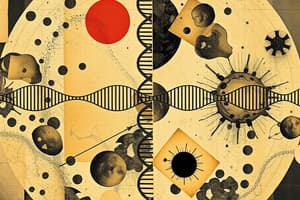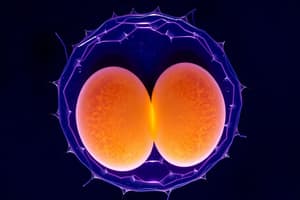Podcast
Questions and Answers
What is the primary outcome of meiosis in gamete cells?
What is the primary outcome of meiosis in gamete cells?
- It has no impact on genetic variability.
- It reduces the chromosome number by half. (correct)
- It doubles the chromosome number.
- It creates identical daughter cells.
Which of the following best describes the emotional effects of cancer on patients and families?
Which of the following best describes the emotional effects of cancer on patients and families?
- It can lead to stress, anxiety, and depression. (correct)
- It usually causes minimal emotional impact.
- It has no impact on daily life.
- It improves family relationships.
What aspect of cancer treatment can strain families financially?
What aspect of cancer treatment can strain families financially?
- Low healthcare costs.
- The financial burden of ongoing treatment. (correct)
- Insurance coverage typically increases.
- Increased productivity at work.
What is a key cellular process that leads to genetic variability during meiosis?
What is a key cellular process that leads to genetic variability during meiosis?
What is a significant implication of understanding cellular mechanisms in the context of diseases like cancer?
What is a significant implication of understanding cellular mechanisms in the context of diseases like cancer?
What is zoology primarily concerned with?
What is zoology primarily concerned with?
Which of the following best describes the scientific method?
Which of the following best describes the scientific method?
What does the term 'Hierarchical Organization' refer to in biology?
What does the term 'Hierarchical Organization' refer to in biology?
Which property of living things involves the synthesis of necessary molecules for survival?
Which property of living things involves the synthesis of necessary molecules for survival?
What is a key aspect of the genetic program in living organisms?
What is a key aspect of the genetic program in living organisms?
Which subdivision of zoology focuses specifically on the study of fish?
Which subdivision of zoology focuses specifically on the study of fish?
Which characteristic described as 'emergent properties' is found at different biological levels?
Which characteristic described as 'emergent properties' is found at different biological levels?
What is not considered a general property of living things?
What is not considered a general property of living things?
What is defined as a molecule in the context of chemistry?
What is defined as a molecule in the context of chemistry?
Which type of chemical reaction is characterized by the combination of atoms or molecules with energy absorption?
Which type of chemical reaction is characterized by the combination of atoms or molecules with energy absorption?
Which of the following best describes an inorganic compound?
Which of the following best describes an inorganic compound?
What role does hydrolysis play in biological processes?
What role does hydrolysis play in biological processes?
Which biomolecule is primarily involved in energy storage and provides structural support in cells?
Which biomolecule is primarily involved in energy storage and provides structural support in cells?
What is the process called that involves the removal of a water molecule to form a new bond?
What is the process called that involves the removal of a water molecule to form a new bond?
In biological systems, macromolecules such as proteins and nucleic acids are primarily formed through which type of reaction?
In biological systems, macromolecules such as proteins and nucleic acids are primarily formed through which type of reaction?
Which of the following statements about organic compounds is true?
Which of the following statements about organic compounds is true?
Which type of carbohydrate is composed of two monosaccharides?
Which type of carbohydrate is composed of two monosaccharides?
What is the primary function of triglycerides?
What is the primary function of triglycerides?
Which type of protein is primarily responsible for facilitating biochemical reactions?
Which type of protein is primarily responsible for facilitating biochemical reactions?
Which of the following is NOT a type of lipid?
Which of the following is NOT a type of lipid?
Which biomolecule serves as the blueprint of life?
Which biomolecule serves as the blueprint of life?
What process is essential for the breakdown of biomolecules?
What process is essential for the breakdown of biomolecules?
Which level of protein organization involves the folding of a polypeptide into a three-dimensional shape?
Which level of protein organization involves the folding of a polypeptide into a three-dimensional shape?
Which functional group is NOT part of a nucleotide?
Which functional group is NOT part of a nucleotide?
What did Mathias Schleiden and Theodor Schwann contribute to cell theory?
What did Mathias Schleiden and Theodor Schwann contribute to cell theory?
Which characteristic is unique to eukaryotic cells compared to prokaryotic cells?
Which characteristic is unique to eukaryotic cells compared to prokaryotic cells?
Which of these structures is NOT found in prokaryotic cells?
Which of these structures is NOT found in prokaryotic cells?
How does passive transport differ from active transport in cellular processes?
How does passive transport differ from active transport in cellular processes?
What are the main regions that a typical cell consists of?
What are the main regions that a typical cell consists of?
What role do microvilli serve in a cell?
What role do microvilli serve in a cell?
During which phase of the cell cycle does DNA replication occur?
During which phase of the cell cycle does DNA replication occur?
What is a major function of the plasma membrane?
What is a major function of the plasma membrane?
Flashcards are hidden until you start studying
Study Notes
Cell Division and Meiosis
- Stages of cell division: Prophase, Metaphase, Anaphase, Telophase, followed by cytokinesis.
- Meiosis occurs in gamete (sex) cells, halving chromosome number and enhancing genetic variability through processes like crossing over and independent assortment.
Impact of Cancer
- Physical and Emotional Effects: Cancer severely affects physical health, leading to debilitating symptoms impacting daily life. Emotional challenges for patients and families often result in stress, anxiety, and depression.
- Socioeconomic Implications: Cancer treatment imposes significant financial burdens on families, affecting their quality of life. Societal costs include increased healthcare expenditures and lost productivity.
Importance of Cell Study
- Understanding cellular structure and function is fundamental to grasping the essence of life.
- Insights into cellular processes, particularly in diseases like cancer, reveal profound implications for individuals and society.
- Knowledge of cellular mechanisms is vital for advancing medical science and improving treatment strategies.
Zoology Overview
- Zoology provides a comprehensive study of animal life, exploring its complexities through biological principles.
- Key terms include:
- Zoology: Scientific study of animal life.
- Science: Systematic organization of knowledge through inquiry.
- Scientific Method: Structured approach involving observation, questioning, and empirical testing.
- Hierarchical Organization: Life's organization from subatomic particles to the biosphere.
General Properties of Living Organisms
- Chemical Uniqueness: Organisms show complex molecular organization with macromolecules like nucleic acids and proteins.
- Complexity and Hierarchical Organization: Life features multiple levels from macromolecules to ecosystems, where emergent properties are observed.
- Reproduction: Capable at various levels, from gene replication to new species formation.
- Genetic Program: DNA encodes genetic information, enabling inheritance and evolution.
- Metabolism: Essential for maintaining life through processes like digestion and energy production.
- Development: Characteristic life stages from origin to maturity shape organisms.
Chemistry of Life
- Fundamental to understanding biological interactions, this encompasses subatomic to macromolecular structures.
- Molecules vs. Compounds:
- Molecule: Formed by two or more like atoms.
- Compound: Formed by two or more different atoms.
- Key Chemical Reactions:
- Synthesis Reaction: Energy-absorbing combination of molecules.
- Decomposition Reaction: Energy-releasing breakdown of molecules.
- Dehydration Reaction: Removal of water to form chemical bonds.
- Hydrolysis: Addition of water to break chemical bonds.
Major Biomolecules
- Carbohydrates: Composed of carbon, hydrogen, and oxygen with types including monosaccharides (simple sugars), disaccharides (two sugars), and polysaccharides (long sugar chains).
- Lipids: Higher carbon and hydrogen ratio; includes triglycerides (energy storage), phospholipids (cell membranes), and steroids (hormones).
- Proteins: Composed of amino acids; types include enzymes, structural proteins, and transport proteins with levels of organization from primary to quaternary.
- Nucleic Acids: The blueprint of life (DNA and RNA), made of nucleotides including a nitrogenous base, sugar, and phosphate group.
Cell Theory and Types of Cells
- Cell Theory Contributors: Robert Hooke (cell discovery), Mathias Schleiden, and Theodor Schwann formulated the principles that all organisms are composed of cells and that cells arise from pre-existing cells.
- Prokaryotic Cells: Lack membrane-bound nucleus; genetic material is in nucleoid and includes archaea and bacteria.
- Eukaryotic Cells: Have a membrane-bound nucleus; more complex with specialized organelles and a cytoskeleton.
Cell Structure and Physiology
- Major Cell Regions: Plasma membrane, cytoplasm, and nucleus.
- Plasma Membrane: Fluid-mosaic model; acts as a barrier with a double phospholipid layer, proteins, cholesterol, and glycoproteins.
- Transport Mechanisms:
- Passive Transport: No energy needed (diffusion, osmosis).
- Active Transport: Requires energy to move substances against gradients.
- Cell Cycle: Includes Interphase (G1, S, G2) for growth and Mitosis for cell division, maintaining chromosome number.
Studying That Suits You
Use AI to generate personalized quizzes and flashcards to suit your learning preferences.




